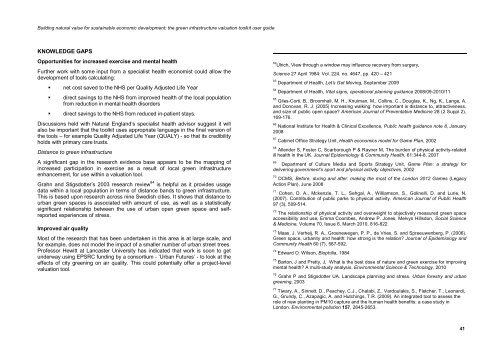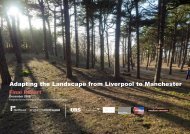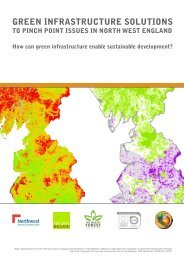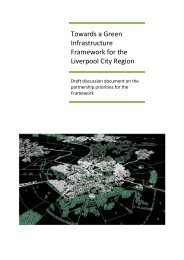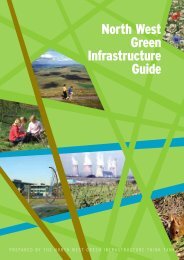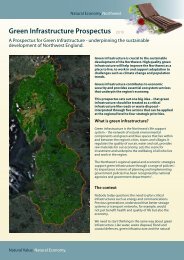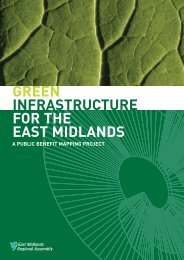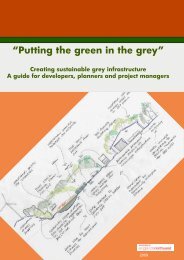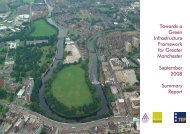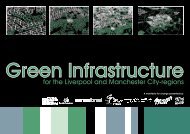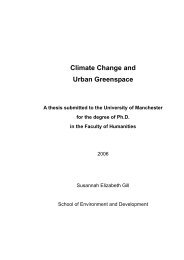The green infrastructure valuation toolkit user guide
The green infrastructure valuation toolkit user guide
The green infrastructure valuation toolkit user guide
Create successful ePaper yourself
Turn your PDF publications into a flip-book with our unique Google optimized e-Paper software.
Building natural value for sustainable economic development: the <strong>green</strong> <strong>infrastructure</strong> <strong>valuation</strong> <strong>toolkit</strong> <strong>user</strong> <strong>guide</strong><br />
KNOWLEDGE GAPS<br />
Opportunities for increased exercise and mental health<br />
Further work with some input from a specialist health economist could allow the<br />
development of tools calculating:<br />
<br />
<br />
<br />
net cost saved to the NHS per Quality Adjusted Life Year<br />
direct savings to the NHS from improved health of the local population<br />
from reduction in mental health disorders<br />
direct savings to the NHS from reduced in-patient stays.<br />
Discussions held with Natural England’s specialist health advisor suggest it will<br />
also be important that the <strong>toolkit</strong> uses appropriate language in the final version of<br />
the tools – for example Quality Adjusted Life Year (QUALY) - so that its credibility<br />
holds with primary care trusts.<br />
Distance to <strong>green</strong> <strong>infrastructure</strong><br />
A significant gap in the research evidence base appears to be the mapping of<br />
increased participation in exercise as a result of local <strong>green</strong> <strong>infrastructure</strong><br />
enhancement, for use within a <strong>valuation</strong> tool.<br />
Grahn and Stigsdotter’s 2003 research review 84 is helpful as it provides usage<br />
data within a local population in terms of distance bands to <strong>green</strong> <strong>infrastructure</strong>.<br />
This is based upon research across nine Swedish cities. It shows that distance to<br />
urban <strong>green</strong> spaces is associated with amount of use, as well as a statistically<br />
significant relationship between the use of urban open <strong>green</strong> space and selfreported<br />
experiences of stress.<br />
Improved air quality<br />
Most of the research that has been undertaken in this area is at large scale, and<br />
for example, does not model the impact of a smaller number of urban street trees.<br />
Professor Hewitt at Lancaster University has indicated that work is soon to get<br />
underway using EPSRC funding by a consortium - ‘Urban Futures’ - to look at the<br />
effects of city <strong>green</strong>ing on air quality. This could potentially offer a project-level<br />
<strong>valuation</strong> tool.<br />
62 Ulrich, View through a window may influence recovery from surgery,<br />
Science 27 April 1984: Vol. 224. no. 4647, pp. 420 – 421<br />
63<br />
Department of Health, Let’s Get Moving, September 2009<br />
64<br />
Department of Health, Vital signs, operational planning guidance 2008/09-2010/11<br />
65<br />
Giles-Corti, B., Broomhall, M. H., Knuiman, M., Collins, C., Douglas, K., Ng, K., Lange, A.<br />
and Donovan, R. J. (2005) Increasing walking: how important is distance to, attractiveness,<br />
and size of public open space American Journal of Preventative Medicine 28 (2 Suppl 2),<br />
169-176.<br />
66<br />
National Institute for Health & Clinical Excellence, Public health guidance note 8, January<br />
2008<br />
67<br />
Cabinet Office Strategy Unit, Health economics model for Game Plan, 2002<br />
68<br />
Allender S, Foster C, Scarborough P & Rayner M, <strong>The</strong> burden of physical activity-related<br />
ill health in the UK. Journal Epidemiology & Community Health, 61:344-8, 2007<br />
69<br />
Department of Culture Media and Sports Strategy Unit, Game Plan: a strategy for<br />
delivering government’s sport and physical activity objectives, 2002<br />
70<br />
DCMS, Before, during and after: making the most of the London 2012 Games (Legacy<br />
Action Plan), June 2008<br />
71<br />
Cohen, D. A., Mckenzie, T. L., Sehgal, A., Williamson, S., Golinelli, D. and Lurie, N.<br />
(2007). Contribution of public parks to physical activity. American Journal of Public Health<br />
97 (3), 509-514.<br />
72<br />
<strong>The</strong> relationship of physical activity and overweight to objectively measured <strong>green</strong> space<br />
accessibility and use, Emma Coombes, Andrew P. Jones, Melvyn Hillsdon, Social Science<br />
& Medicine, Volume 70, Issue 6, March 2010, 816-822<br />
73<br />
Maas, J. Verheij, R. A., Groenewegen, P. P., de Vries, S. and Spreeuwenberg, P. (2006).<br />
Green space, urbanity and health: how strong is the relation Journal of Epidemiology and<br />
Community Health 60 (7), 587-592.<br />
74<br />
Edward O. Wilson, Biophilia, 1984<br />
75<br />
Barton, J and Pretty, J, What is the best dose of nature and <strong>green</strong> exercise for improving<br />
mental health A multi-study analysis. Environmental Science & Technology, 2010<br />
76<br />
Grahn P and Stigsdotter UA. Landscape planning and stress. Urban forestry and urban<br />
<strong>green</strong>ing, 2003<br />
77<br />
Tiwary, A., Sinnett, D., Peachey, C.J., Chalabi, Z., Vardoulakis, S., Fletcher, T., Leonardi,<br />
G., Grundy, C., Azapagic, A. and Hutchings, T.R. (2009). An integrated tool to assess the<br />
role of new planting in PM10 capture and the human health benefits: a case study in<br />
London. Environmental pollution 157, 2645-2653.<br />
41


